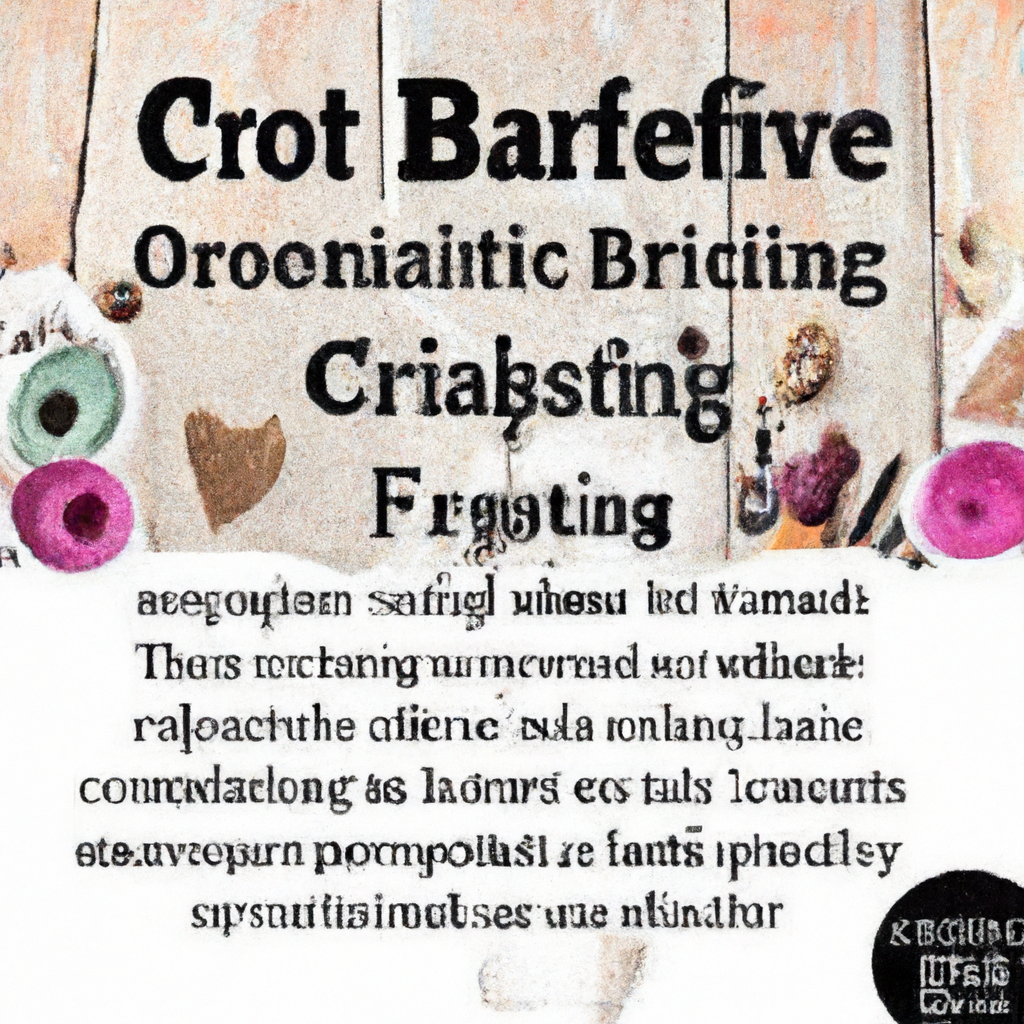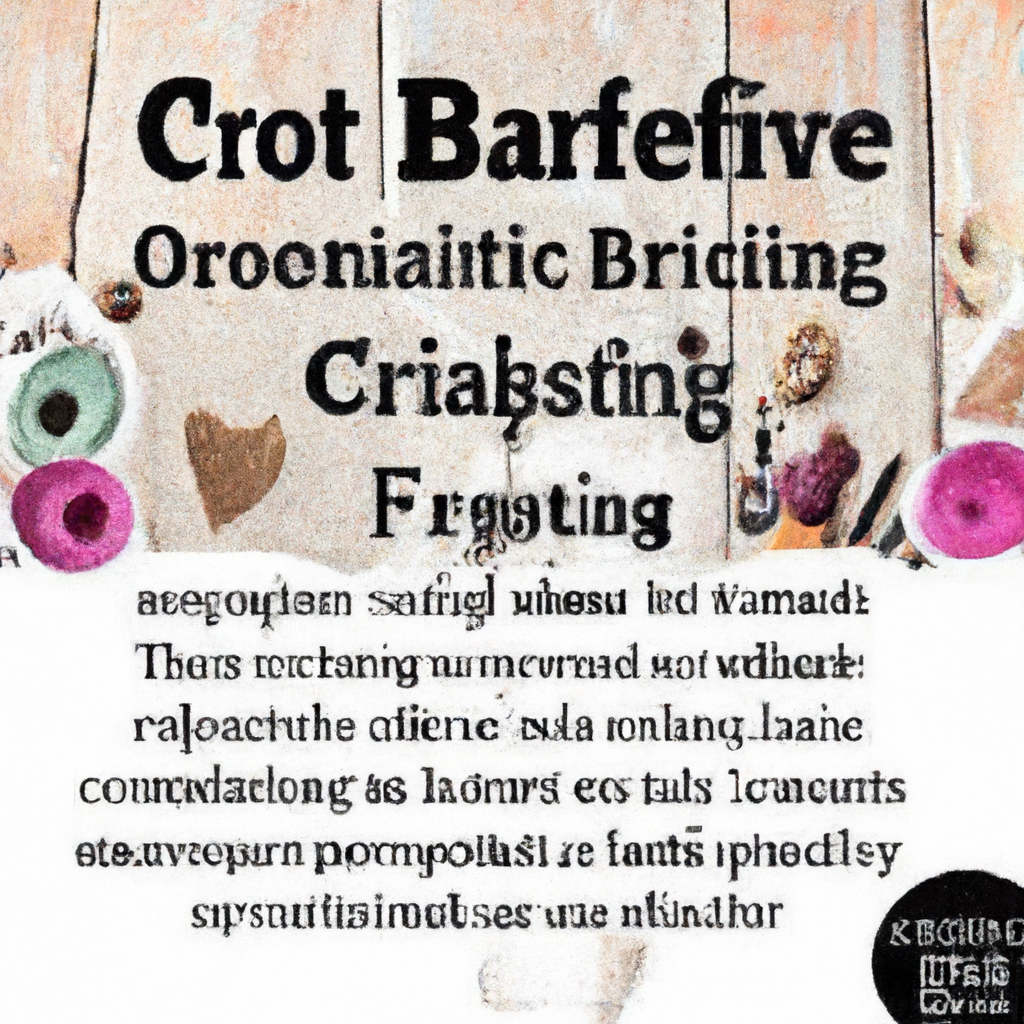Crafting for Profit: Tips and Strategies for Turning Hobbies into Business Ventures, aims to guide readers on the journey of transforming their crafting skills into a lucrative side hustle. This article provides insightful tips and strategies on the art of monetizing your creative passions, ensuring that your hobby becomes a profitable endeavor. Whether you’re an avid knitter, a talented painter, or a skilled woodworker, this article will equip you with the knowledge and know-how to successfully turn your crafts into a thriving business venture. So grab your crafting tools, unleash your creativity, and let’s embark on this exciting entrepreneurial adventure together!

Choosing the Right Craft
Assessing Your Skills and Interests
Before you embark on the journey of turning your hobby into a business, it’s important to assess your skills and interests. Take some time to think about the crafts you enjoy and excel at. Consider what sets you apart from others in terms of technique or style. Reflecting on these aspects will help you select a craft that you are passionate about and confident in.
Researching Market Demand
While it’s important to choose a craft that you enjoy, it’s equally crucial to consider the market demand for your chosen craft. Conduct thorough research and identify if there is a viable market for the products you will be creating and selling. Look for trends, niche markets, and potential customers. By understanding the market demand, you can ensure that you are investing your time and effort into a craft that has the potential to generate sales and profit.
Building a Brand
Defining Your Target Audience
Once you have chosen your craft, it’s time to define your target audience. Think about who would be interested in purchasing your products. Consider factors such as age, gender, interests, and preferences. This information will help you tailor your marketing efforts and create products that resonate with your target audience.
Creating a Unique Selling Point
In a competitive market, it’s essential to stand out from the crowd. Develop a unique selling point (USP) that sets your crafts apart. This could be a specific feature, a distinctive design element, or even a story behind your products. Your USP will help you attract customers and differentiate yourself from other crafters.
Designing a Memorable Logo
To establish a strong brand identity, it’s important to design a memorable logo. Your logo should be visually appealing, represent your craft, and resonate with your target audience. Consider hiring a professional designer or utilizing online tools to create a logo that embodies the essence of your brand.
Setting Up Shop
Deciding on a Business Structure
Before you start selling your crafts, you need to decide on a business structure. Options include sole proprietorship, partnership, or forming a limited liability company (LLC). Each structure has its benefits and implications, so it’s important to research and determine which one aligns with your goals and circumstances.
Registering Your Business
To operate your crafting business legally, you need to register it with the appropriate authorities. This may involve obtaining a business license, registering your business name, or applying for any required permits. Check with your local government or Small Business Administration for the specific requirements in your area.
Creating an Online Presence
In today’s digital age, having an online presence is essential for any business. Set up a website or an online store where customers can browse and purchase your crafts. Utilize social media platforms to showcase your products, connect with potential customers, and build a following. Consider professional product photography to present your crafts in the best possible light.
Pricing Your Crafts
Calculating Costs and Profit Margins
To determine the appropriate pricing for your crafts, you need to calculate your costs and profit margins. Consider the cost of materials, labor, packaging, shipping, and overhead expenses. Factor in the time you spend creating each piece and assign an hourly rate for your work. By understanding your costs and desired profit margins, you can set prices that cover expenses and generate a sustainable income.
Researching Competitor Pricing
Researching competitor pricing is crucial in determining the pricing strategy for your crafts. Look at similar crafts in your niche and analyze their pricing structure. Consider their quality, unique features, and brand positioning. While it’s important to be competitive, don’t undervalue your products. Ensure that your pricing accurately reflects the value and quality you offer.
Considering Perceived Value
Perceived value plays a significant role in a customer’s decision to purchase your crafts. Consider how your brand, packaging, and presentation can enhance the perceived value of your products. Invest in high-quality packaging materials, create an appealing brand story, and provide excellent customer service. By creating a positive and memorable experience, you can increase the perceived value of your crafts.

Sourcing Materials
Finding Affordable Suppliers
Sourcing materials at affordable prices is essential to maintain a healthy profit margin. Research and explore different suppliers, both locally and online, to find the best prices for the materials you need. Consider purchasing in bulk or joining wholesale memberships to benefit from volume discounts. Don’t compromise on quality, but strive to find a balance between affordability and the materials’ overall value.
Evaluating Quality and Sustainability
While affordability is important, it’s equally critical to ensure the quality and sustainability of your materials. Your crafts represent your brand, so using high-quality materials is essential for customer satisfaction and the reputation of your business. Additionally, consider sustainable sourcing options and eco-friendly materials to appeal to environmentally conscious customers. Balancing quality and sustainability will help you create crafts that are both appealing and responsible.
Optimizing Workflow
Organizing Workspace and Tools
Efficiency is key when running a crafting business. Take the time to organize your workspace and tools in a way that maximizes productivity. Arrange your materials, tools, and equipment in a logical and accessible manner. Create designated areas for different stages of production to streamline your workflow.
Streamlining Production Processes
Streamlining production processes can greatly increase your output and efficiency. Identify areas where you can eliminate unnecessary steps or automate certain tasks. Look for opportunities to batch similar processes together to minimize downtime and maximize productivity. Regularly evaluate and optimize your production processes to ensure a smooth and efficient workflow.
Marketing and Selling
Identifying Effective Marketing Channels
To effectively market and sell your crafts, it’s important to identify the most suitable marketing channels for your target audience. Consider platforms such as social media, online marketplaces, craft fairs, or even collaborations with complementary businesses. Allocate time and resources to each marketing channel based on their potential to reach and engage your target audience.
Creating Compelling Product Descriptions
When selling your crafts online, compelling product descriptions are essential. Craft detailed and engaging descriptions that highlight the unique features, materials used, and the story behind each product. Use descriptive language, and consider incorporating keywords that potential customers may use when searching for similar items. Invest time in crafting persuasive product descriptions to capture the attention and interest of potential buyers.
Utilizing Social Media for Promotion
Social media is a powerful tool for promoting your crafts and connecting with customers. Establish a strong social media presence on platforms that align with your target audience. Share high-quality photos, engaging content, and behind-the-scenes peeks into your creative process. Interact with followers, respond to comments and messages promptly, and use social media to build a loyal community around your brand.
Participating in Craft Fairs or Markets
Craft fairs and markets provide valuable opportunities to showcase and sell your crafts in-person. Research local events and consider participating as a vendor. Prepare visually appealing displays, bring a variety of products to cater to different tastes, and engage with potential customers. Craft fairs not only generate sales but also offer valuable feedback and networking opportunities.
Building Customer Relationships
Providing Excellent Customer Service
Building strong customer relationships is essential for the long-term success of your crafting business. Provide excellent customer service by being responsive, friendly, and accommodating. Address any concerns or issues promptly and go the extra mile to exceed customer expectations. Positive customer experiences lead to repeat business, word-of-mouth referrals, and a loyal customer base.
Using Packaging and Branding to Enhance Customer Experience
Packaging and branding play a significant role in enhancing the overall customer experience. Invest in high-quality packaging materials that reflect the value of your crafts. Consider incorporating your brand colors, logo, and a personalized thank-you note to make your customers feel special and appreciated. Attention to detail in your packaging can leave a lasting impression and encourage customer loyalty.
Expanding Your Business
Diversifying Product Range
As your business grows, consider diversifying your product range to cater to a broader customer base. Explore new craft ideas or variations of your existing products. Take feedback from customers and market trends into consideration. By offering a diverse range, you can attract new customers and keep your existing ones engaged and coming back for more.
Collaborating with Other Crafters
Collaborating with other crafters can help expand your reach and tap into new audiences. Identify crafters in complementary niches and explore collaboration opportunities. You could create limited-edition collaborative products or host joint events. Collaborations not only bring fresh perspectives but also allow you to share resources and cross-promote each other’s businesses.
Scaling Up Production
If demand for your crafts exceeds your production capacity, it may be time to consider scaling up. Explore ways to increase production efficiency, such as investing in more equipment or hiring additional help. However, ensure that scaling up does not compromise the quality or uniqueness of your crafts. Monitor demand and evaluate the feasibility of scaling up to meet customer needs while maintaining the integrity of your brand.
Managing Finances
Tracking Income and Expenses
As a business owner, it’s important to keep track of your income and expenses. Develop a system to accurately record all financial transactions related to your crafting business. This will help you monitor profitability, identify areas for improvement, and ensure you meet your financial goals. Consider using accounting software or consulting with a professional to streamline your financial management.
Investing in Tools and Equipment
Investing in quality tools and equipment is crucial for maintaining productivity and the quality of your crafts. Assess your needs and budget to determine which tools are essential for your craft. Prioritize investments that will improve efficiency and the overall value of your products. Track the return on investment and periodically review if any new tools or equipment are needed.
Hiring Help and Outsourcing
As your business grows, you may find it beneficial to hire help or outsource certain tasks. Evaluate your workload and identify areas where additional assistance can be valuable. This could include hiring an assistant to help with administrative tasks or working with freelancers for specific projects. Outsourcing tasks can free up your time and allow you to focus on the core aspects of your business.
By following these comprehensive steps, you can successfully turn your crafting hobby into a thriving business venture. Remember to stay true to your passion, continuously adapt to market trends, and provide exceptional customer experiences. Building a successful crafting business requires dedication, creativity, and a commitment to continuous improvement. Good luck on your journey from hobby to business!


